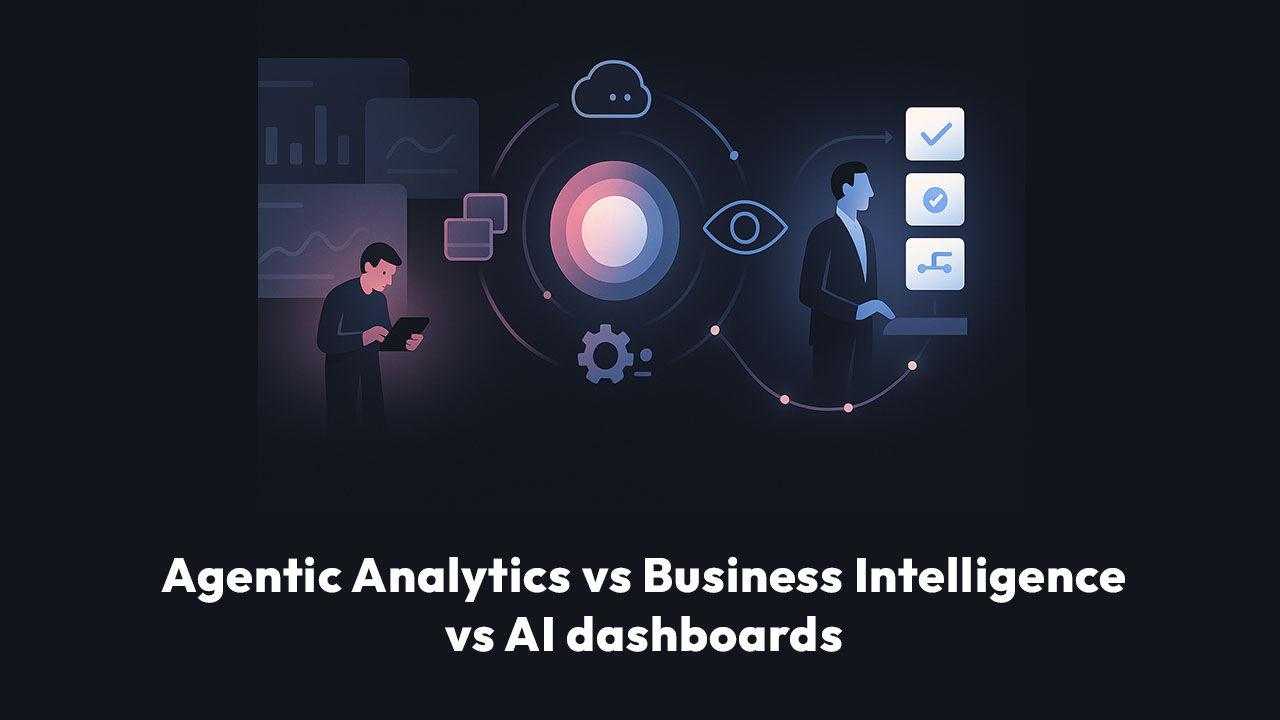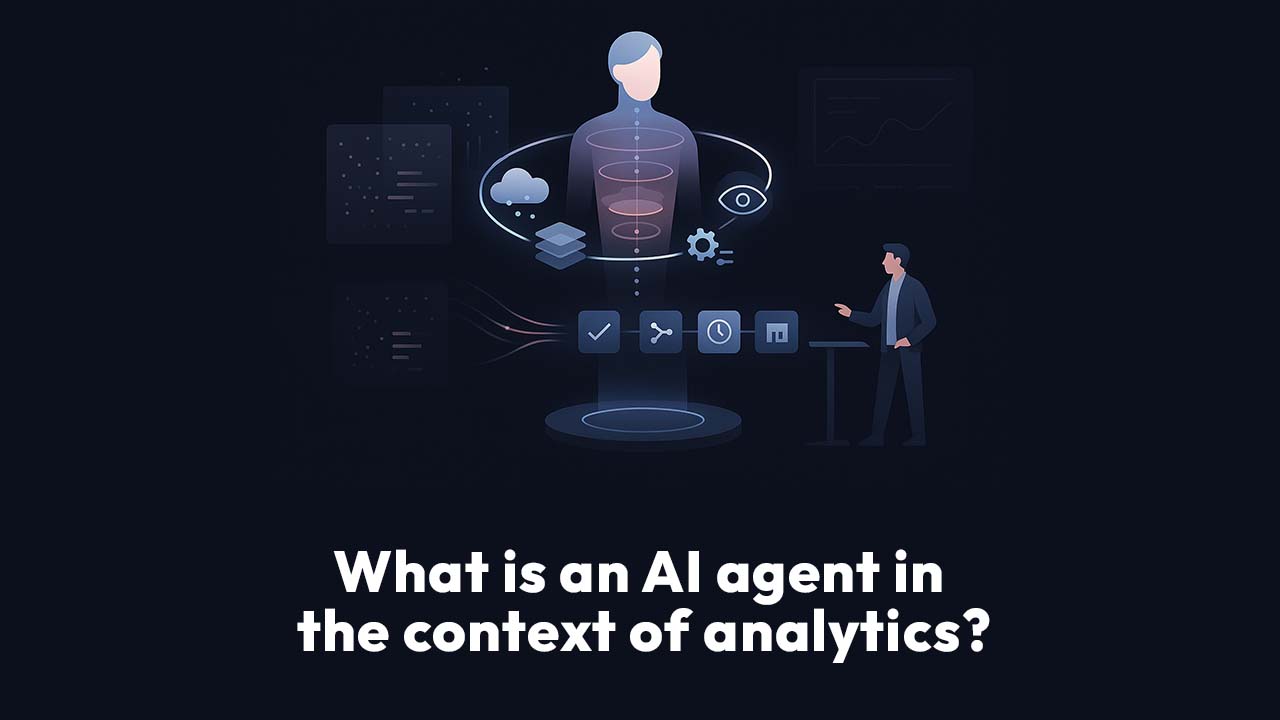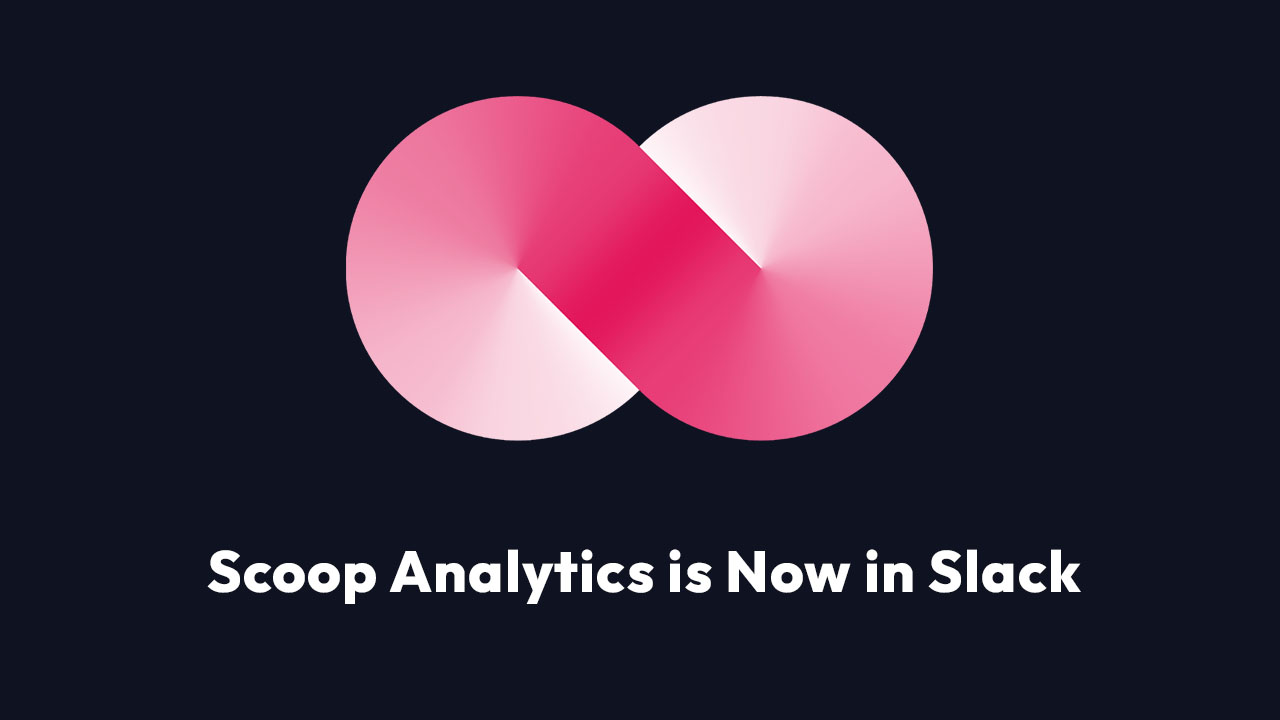What Is Agentic Analytics? (And Why Should You Care?)
Agentic analytics represents a paradigm shift in how organizations interact with their data. Rather than requiring data scientists to manually build models or business users to wrestle with complex BI dashboards, agentic analytics deploys AI agents that autonomously investigate business questions, run sophisticated machine learning algorithms, and deliver actionable insights in plain English.
Think of it this way: traditional analytics is like having a library full of books. Agentic analytics is like having a PhD researcher who reads all those books, synthesizes the information, and answers your specific questions with cited evidence. The AI doesn't just retrieve data—it reasons through problems, tests multiple hypotheses simultaneously, and provides recommendations backed by statistical confidence.
Here's what makes agentic analytics fundamentally different:
- Autonomous investigation: The system decides which analytical approaches to use based on your question
- Multi-step reasoning: Tests multiple hypotheses in parallel, not just single queries
- Explainable ML: Runs sophisticated algorithms (decision trees, clustering, rule learning) but explains results in business terms
- Action-oriented: Doesn't stop at insights—provides specific, prioritized recommendations
The global market for augmented analytics is projected to reach $29.5 billion by 2028, with agentic approaches leading the charge. But more impressive than the market size? Organizations using agentic analytics report finding insights 90% faster than traditional methods—and discovering patterns they never would have found manually.
How Does Agentic Analytics Power Predictive Analytics?
The Problem with Traditional Predictive Analytics
We've all been there. A data scientist spends weeks building a predictive model, presents accuracy metrics that sound impressive (87% accuracy!), and then... business users have no idea what to do with it. The model sits unused because:
- It's a black box—nobody understands why predictions are made
- It requires technical expertise to interpret
- The insights don't translate to actionable business decisions
- By the time it's deployed, business conditions have changed
Agentic analytics solves this through a three-layer architecture that's revolutionizing predictive analytics:
Layer 1: Automatic Data Preparation (The Invisible Work)
Before any prediction can happen, data needs professional-grade preparation. Traditional approaches require data scientists to spend 70-80% of their time on this. Agentic systems handle it automatically:
- Missing value imputation: Intelligently fills gaps based on patterns
- Outlier detection and handling: Identifies and manages extreme values
- Feature engineering: Creates derived variables (ratios, time-based features, interactions)
- Smart binning: Converts continuous variables into interpretable ranges
- Class balancing: Ensures the model doesn't favor majority classes
This happens in milliseconds, completely invisible to the user. You ask a question, and the system prepares production-quality data science inputs without you knowing it occurred.
Layer 2: Sophisticated ML Execution (Real Data Science)
Here's where agentic analytics runs actual machine learning algorithms—not simple rules or basic statistics:
J48 Decision Trees: These can be 800+ nodes deep, exploring every possible decision path through your data. They're not the simplified decision trees you might have seen in presentations—these are PhD-level models that can handle dozens of variables simultaneously.
JRip Rule Learning: Generates hundreds of if-then rules with coverage statistics, showing exactly which combinations of factors predict outcomes.
EM Clustering: Statistical clustering algorithms that find natural groupings with probability distributions and confidence scores.
The difference? A human analyst might test 3-5 hypotheses manually over several hours. An agentic system tests 50+ in seconds, finding patterns across combinations of variables that would take weeks to discover manually.
Layer 3: AI Explanation Engine (Business Translation)
This is the magic layer that makes agentic analytics accessible. Real ML produces complex, technical output—an 800-node decision tree is "explainable" in theory but incomprehensible in practice. The AI explanation layer analyzes complex model output and translates it:
Technical Output: "Decision tree with 847 nodes, 243 leaf nodes, weighted F-measure 0.893, cross-validation accuracy 89.3%"
Business Translation: "High-risk churn customers share three characteristics: more than 3 support tickets in 30 days (89% accuracy), no login activity for 30+ days, and less than 6 months tenure. Immediate intervention on this segment can prevent 60-70% of predicted churn. Priority contacts: 47 customers matching all criteria."
See the difference? Same sophisticated analysis, but one version drives action while the other collects dust.
Real-World Predictive Analytics Use Cases
Use Case 1: Customer Churn Prevention (45 Days of Warning)
The Traditional Approach:Sales rep discovers at renewal meeting that customer is leaving. Too late to save the relationship—they've already made the decision.
The Agentic Analytics Approach:
A customer success manager asks in Slack: "Which enterprise customers are at risk?"
Within 45 seconds, the agentic system:
- Analyzes 50+ behavioral signals across engagement, support, usage, and sentiment
- Runs ML models comparing churned vs. retained customer patterns
- Identifies at-risk accounts with confidence scores
- Provides specific warning signs and intervention strategies
Real Result:
Business Impact: A B2B company implementing these recommendations saw 71% revenue increase with the same budget—an additional $586K. The key wasn't spending more, but allocating resources to high-performing channels identified through multi-variable analysis that would have taken weeks manually.
How to Define Agentic in Your Analytics Context
When implementing agentic analytics, understanding what "agentic" actually means in practice helps set proper expectations:
What Agentic Means:
Autonomous Investigation: The system decides which analytical approaches to apply based on the question type, not based on predefined rules. Ask about churn, it knows to run classification models. Ask about segments, it knows to use clustering.
Goal-Oriented Behavior: The AI has an objective—answer the business question completely. It will execute multiple queries, test multiple hypotheses, and synthesize findings until it reaches a satisfactory answer.
Adaptive Strategy: If initial approaches don't yield insights, the system tries alternative methods. Failed query? It reformulates. Inconclusive results? It tests additional hypotheses.
Context Retention: Remembers previous analyses in the conversation, builds on prior findings, and maintains business context across multiple interactions.
What Agentic Doesn't Mean:
Not Fully Autonomous: These systems work within defined boundaries and governed data access. They don't make business decisions—they provide analysis for human decision-making.
Not Magic: The "agency" comes from sophisticated orchestration of known ML algorithms, not from some mysterious AI capability. Every step is traceable and auditable.
Not Replacement for Data Teams: Agentic analytics amplifies data teams by handling routine discovery work, freeing them for strategic initiatives. It's augmentation, not replacement.
Implementation Framework: Getting Started with Agentic Analytics
Phase 1: Foundation (Week 1-2)
Connect Your Data Sources
- Start with 2-3 critical systems (CRM, product analytics, support data)
- Ensure data quality basics (no duplicates, consistent customer IDs)
- Don't wait for perfect data—agentic systems handle messy data better than traditional tools
Identify Quick Win Use Cases
- Revenue investigation: "Why did metric X change?"
- Churn prediction: "Which customers are at risk?"
- Segmentation: "What patterns exist in our customer base?"
Train Power Users
- Select 5-10 analytically-curious business users
- Focus on question formulation, not technical training
- Encourage experimentation and iteration
Phase 2: Expansion (Week 3-8)
Broaden Data Connections
- Add financial systems, marketing platforms, operational data
- Enable cross-system analysis for richer insights
- Implement row-level security and governance
Deploy Predictive Models
- Identify high-value prediction use cases (churn, conversion, deal closure)
- Let agentic system build and explain models
- Push predictions back to operational systems (CRM, marketing automation)
Build Analysis Library
- Save high-value questions and analyses
- Create templates for common investigations
- Enable self-service for broader user base
Phase 3: Optimization (Week 9+)
Prescriptive Applications
- Move beyond prediction to prescription
- Implement "what should we do?" workflows
- Build closed-loop feedback systems
Advanced Integration
- API-based orchestration with other systems
- Automated investigation triggers
- Scheduled analysis and monitoring
Scale Adoption
- Expand to additional departments
- Measure and communicate ROI
- Build analytics community of practice
Measuring Success: KPIs for Agentic Analytics
Time Metrics
- Time to insight: 45 seconds vs. 4 hours (benchmark: 90% reduction)
- Analysis throughput: 10× more questions answered per analyst
- Decision velocity: Days to hours for complex decisions
Adoption Metrics
- Active users: Target 80%+ of intended audience
- Questions asked: 50+ per user per month indicates healthy adoption
- Self-service rate: 70% of analyses without data team involvement
Business Impact Metrics
- Revenue influenced: Track decisions driven by insights
- Cost avoidance: Churn prevented, inefficient spending eliminated
- Opportunity capture: New segments discovered, expansion identified
Quality Metrics
- Prediction accuracy: 85-90% for classification models
- User satisfaction: Net Promoter Score for the analytics platform
- Trust score: Percentage of recommendations implemented
Common Pitfalls and How to Avoid Them
Pitfall 1: Treating It Like Traditional BI
The Mistake: Expecting agentic analytics to replace dashboards and reports.
The Reality: Agentic analytics excels at discovery and investigation, not operational reporting. Use it for "why" and "what should we do" questions, keep traditional BI for "what happened" monitoring.
The Fix: Position agentic analytics as the discovery layer complementing your BI stack, not replacing it.
Pitfall 2: Over-Reliance Without Validation
The Mistake: Blindly following every recommendation without business judgment.
The Reality: Agentic systems provide statistically-backed recommendations, but they don't have full business context about market conditions, strategic initiatives, or organizational constraints.
The Fix: Treat prescriptions as expert input, not final decisions. Validate against business reality and strategic goals.
Pitfall 3: Poor Data Quality Tolerance
The Mistake: Assuming agentic systems can magically fix fundamentally broken data.
The Reality: While agentic analytics handles messy data better than traditional tools, it can't overcome systematic data quality issues. Garbage in, garbage out still applies.
The Fix: Establish basic data hygiene standards. The system will handle missing values and outliers, but you need consistent customer IDs and reasonable data freshness.
The Future: Where Agentic Analytics Is Heading
Multi-Agent Collaboration
Current agentic systems are single agents. The future? Multiple specialized agents working together—one for customer analytics, another for financial modeling, a third for operational metrics—collaborating to answer complex questions spanning multiple domains.
Proactive Intelligence
Instead of waiting for questions, agentic systems will monitor business metrics continuously and proactively surface important findings: "I noticed an unusual pattern in enterprise deal velocity—should I investigate?"
Closed-Loop Learning
As businesses act on prescriptive recommendations, agentic systems will learn which interventions actually worked, continuously improving their prescriptions based on real-world outcomes.
Natural Language to Action
Beyond analysis and recommendation, future agentic systems will take automated action: adjust campaign budgets, trigger customer outreach, modify pricing—all with appropriate guardrails and human oversight.
FAQ: Agentic Analytics for Predictive and Prescriptive Analytics
What's the difference between agentic analytics and traditional predictive analytics?
Traditional predictive analytics requires data scientists to manually build models, which then need interpretation by business users. Agentic analytics autonomously investigates questions, runs appropriate ML algorithms, and explains results in business language—all in response to natural language questions. Think of it as having a data scientist investigate your question versus running a pre-built model.
How accurate are predictions from agentic analytics systems?
Properly implemented agentic analytics achieves 85-95% accuracy for classification problems (like churn prediction or deal scoring), comparable to manually-built models. The key advantage isn't higher accuracy but faster development and transparent explainability. You understand why each prediction is made, building trust in the system.
Do I need a data science team to use agentic analytics?
No. That's the core innovation—making sophisticated ML accessible to business users without technical skills. However, data teams play a crucial role in governance, validation, and advanced customization. Agentic analytics amplifies data teams by handling routine discovery work.
Can agentic analytics work with our existing BI tools?
Yes. Agentic analytics complements traditional BI by adding the investigation and ML layer. Keep your dashboards for operational monitoring; add agentic analytics for discovery, root cause analysis, and predictive insights. Many implementations integrate with existing BI platforms through APIs.
How long does implementation take?
Initial value in 30 seconds to 2 weeks, depending on data complexity. Unlike traditional BI implementations (6-12 months), agentic systems can connect to data sources and start delivering insights immediately. Full enterprise deployment with governance and multiple use cases typically takes 6-8 weeks.
What's the ROI of implementing agentic analytics?
Organizations report 300-500% productivity improvements for business analysts, 70% reduction in ad-hoc analysis requests to data teams, and 40-60% increase in marketing ROI through better targeting. Typical payback period is 3-6 months. The bigger impact? Finding insights that drive millions in new revenue or saved costs that traditional analysis would miss entirely.
How do prescriptive recommendations differ from just showing data?
Descriptive analytics: "Revenue dropped 15%"
Predictive analytics: "Revenue will likely drop another 10% next month"
Prescriptive analytics: "Implement these three specific actions (prioritized by impact) to recover $580K in the next 30 days, here's why they'll work, and here's the expected outcome of each"
Prescriptive goes beyond identifying problems to providing specific, prioritized, actionable solutions with expected outcomes.
Is explainability really possible with complex ML models?
Yes—when you use inherently interpretable algorithms. Agentic analytics uses decision trees, rule learning, and clustering algorithms that are explainable by design. Unlike neural networks (black boxes), these methods show exactly why predictions are made. The three-layer approach then translates technical explanations into business language.
What types of business questions work best with agentic analytics?
Excellent for:
- "Why did X change?" (root cause investigation)
- "What factors predict Y?" (relationship discovery)
- "What patterns exist in our data?" (segmentation)
- "Which customers will churn?" (prediction)
- "What should we do about X?" (prescription)
Less suitable for:
- Simple lookups ("What was revenue last month?")
- Pre-defined reporting (use traditional BI)
- Extremely specialized domain expertise (supplement, don't replace experts)
How does agentic analytics handle data privacy and governance?
Enterprise agentic systems inherit security and access controls from source systems. Row-level security ensures users only see data they're authorized to access. All analyses are auditable with complete lineage tracking. The system operates within defined boundaries and doesn't move or copy data unnecessarily.
Taking Action: Your Next Steps
The shift from reactive reporting to predictive and prescriptive analytics isn't coming—it's here. Organizations using agentic analytics are already discovering insights faster, predicting outcomes more accurately, and acting on data-driven recommendations that drive measurable business impact.
Where to start:
- Identify one high-value use case: Churn prevention, pipeline prediction, or segmentation discovery
- Connect critical data sources: Start with 2-3 systems containing your most important business data
- Ask ambitious questions: "Why are we losing customers?" not "Show me churn rate"
- Act on the prescriptions: The insights only matter if they drive decisions
- Measure and iterate: Track what works, refine your approach, expand to new use cases
The competitive advantage doesn't go to companies with the most data or the biggest BI budgets. It goes to organizations that can turn questions into insights and insights into action—faster than their competition.
Ready to move beyond dashboards to true predictive and prescriptive intelligence? The technology exists today. The question isn't whether agentic analytics will transform business intelligence—it's whether you'll lead or follow that transformation.








.png)